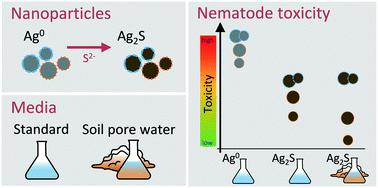当前位置:
X-MOL 学术
›
Environ. Sci.: Nano
›
论文详情
Our official English website, www.x-mol.net, welcomes your feedback! (Note: you will need to create a separate account there.)
Chemical transformation and surface functionalisation affect the potential to group nanoparticles for risk assessment
Environmental Science: Nano ( IF 7.3 ) Pub Date : 2020-08-28 , DOI: 10.1039/d0en00578a Carolin L. Schultz 1, 2, 3 , Jessica Adams 1, 3, 4, 5, 6 , Kerstin Jurkschat 3, 7, 8, 9 , Stephen Lofts 1, 3, 4 , David J. Spurgeon 1, 2, 3
Environmental Science: Nano ( IF 7.3 ) Pub Date : 2020-08-28 , DOI: 10.1039/d0en00578a Carolin L. Schultz 1, 2, 3 , Jessica Adams 1, 3, 4, 5, 6 , Kerstin Jurkschat 3, 7, 8, 9 , Stephen Lofts 1, 3, 4 , David J. Spurgeon 1, 2, 3
Affiliation

|
A major challenge in nanomaterial environmental risk assessment is to identify whether different manufactured materials need to be assessed individually or if they can be grouped for assessments based on selected properties. To date, NPs are grouped on the basis that they are manufactured (e.g., pristine materials), but these are rarely present in the environment as many nanomaterials transform before and after entry into the environment. To assess how transformations change relative hazard and, therefore, the potential for grouping, we assessed the toxicity of silver nanoparticles (NPs) of varying sizes (20, 50 nm) and surface functionalisation (PVP, citrate) in their metallic and sulphidised forms to Caenorhabditis elegans in a standard medium lacking organic matter and in extracted soil pore water. The metallic Ag NPs showed only small variations in toxicity, with citrate functionalisation reducing potency and small citrate NPs being least toxic. The toxicity of sulphidised particles was lower than for the pristine forms in all cases, however relative differences among the transformed materials were greater than for the metallic forms. Exposure in soil pore water further reduced toxicity of the citrate, but not PVP functionalised NPs. Overall, transformation reduced citrate functionalised NP toxicity in a size dependent manner, whereas PVP coating preserved similarities across sizes and transformations. Thus despite similar toxicity of the pristine materials, grouping of NPs with a similar coating independent of size appeared only possible for materials with the more persistent PVP surface coating and then only when transformations were first considered.
中文翻译:

化学转化和表面功能化影响对纳米颗粒进行风险评估的可能性
纳米材料环境风险评估的主要挑战是确定是否需要对不同的制造材料进行单独评估,或者是否可以根据选定的特性将它们分组以进行评估。迄今为止,NP是基于它们的制造(例如原始材料)进行分组的,但是由于许多纳米材料在进入环境之前和之后都在环境中发生转化,因此它们在环境中很少存在。为了评估转化如何改变相对危险性以及因此的分组潜力,我们评估了金属和硫化形式的各种尺寸(20、50 nm)的银纳米颗粒(NP)的毒性和表面官能化(PVP,柠檬酸盐)对秀丽隐杆线虫在缺乏有机物的标准培养基中和提取的土壤孔隙水中。金属Ag NPs的毒性仅表现出很小的变化,柠檬酸盐官能化降低了药效,而小柠檬酸盐NPs的毒性最低。在所有情况下,硫化颗粒的毒性均低于原始形式,但转化材料之间的相对差异大于金属形式。暴露于土壤孔隙水中可进一步降低柠檬酸盐的毒性,但不能降低PVP功能化的NP的毒性。总体而言,转化以大小依赖的方式降低了柠檬酸盐官能化的NP毒性,而PVP涂层在大小和转化方面保留了相似性。因此,尽管原始材料具有类似的毒性,
更新日期:2020-10-17
中文翻译:

化学转化和表面功能化影响对纳米颗粒进行风险评估的可能性
纳米材料环境风险评估的主要挑战是确定是否需要对不同的制造材料进行单独评估,或者是否可以根据选定的特性将它们分组以进行评估。迄今为止,NP是基于它们的制造(例如原始材料)进行分组的,但是由于许多纳米材料在进入环境之前和之后都在环境中发生转化,因此它们在环境中很少存在。为了评估转化如何改变相对危险性以及因此的分组潜力,我们评估了金属和硫化形式的各种尺寸(20、50 nm)的银纳米颗粒(NP)的毒性和表面官能化(PVP,柠檬酸盐)对秀丽隐杆线虫在缺乏有机物的标准培养基中和提取的土壤孔隙水中。金属Ag NPs的毒性仅表现出很小的变化,柠檬酸盐官能化降低了药效,而小柠檬酸盐NPs的毒性最低。在所有情况下,硫化颗粒的毒性均低于原始形式,但转化材料之间的相对差异大于金属形式。暴露于土壤孔隙水中可进一步降低柠檬酸盐的毒性,但不能降低PVP功能化的NP的毒性。总体而言,转化以大小依赖的方式降低了柠檬酸盐官能化的NP毒性,而PVP涂层在大小和转化方面保留了相似性。因此,尽管原始材料具有类似的毒性,


























 京公网安备 11010802027423号
京公网安备 11010802027423号